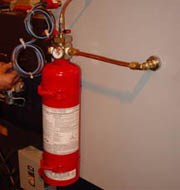Simplifying Fire Prevention
Every machining facility should have a plan in place for fire prevention. An automatic fire suppression system installed on a machine can be the solution.
This video shows a typical Firetrace fire protection installation on a CNC machine.
Every machining facility should have a plan in place for fire prevention. Fires occurring in machines running oil-based coolant can cause significant damage in seconds. Even in the presence of operators, machines have been completely destroyed. In lights-out operations, a fire can continue to grow, potentially damaging other machines, mist collection systems, or even the entire building.
A Firetrace automatic fire suppression system installed on a machine can help alleviate much of this danger. A system such as this installed on a CNC machine allows quick fire detection and suppression, often preventing any damage to the machine.
The red Firetrace detection tubing (FDT) is at the heart of the system. By routing the tubing throughout the machine, the system can detect a fire at its source, no matter where it starts. Proper placement of this tubing reduces activation time and potential for damage. Tests have shown that under normal circumstances, FDT detects a fire 10 times faster than traditional methods.
Upon detection of a fire, the system can discharge a fire-suppressing agent in as little as four seconds. In most machine applications, either Dupont FM-200 or CO2 is the preferred agent. Both of these are clean agents and will leave no residue nor will they contaminate the coolant in the event of a discharge. Firetrace CNC machine fire protection systems can work with a variety of other agents as well for specialized applications and materials such as titanium.
At this time, Firetrace systems are installed on more than 7,500 machines worldwide, and company officials report that at least one incident is reported each week involving a machine that is saved from significant damage. In these incidents, operators frequently report that the system reacts so quickly that the machine is undamaged by the fire. Because of the clean agent fire suppressants that do not contaminate the oil, once the issue that caused the fire is corrected, the machine can be restored to operation with no cleanup necessary.
The Firetrace fire suppression systems aren’t only for use inside the machine tool, but are commonly used throughout the shop floor, in areas such as cleaning tanks, computers, dust and mist collectors, and electrical control cabinets. In fact, their use has spread to a number of other industries, including farming, transportation and heavy duty trucking, and military. One interesting application that has proven particularly effective is use in wind turbines.
Wind turbines manufactured today incorporate the highest quality and safety standards, but the potential for a fire always exists when electronics, flammable oils and hydraulic fluids exist in the same enclosure. Electrical fires can also result from both shorts in equipment and surges due to lightning strikes. Additionally, secondary wind-driven brush fires originating from wind turbine fires can result in significant additional damage.
Given the remote nature of the turbines (mounted over 100 feet in the air or offshore), little can be done from a traditional fire-fighting perspective. A fire suppression system installed in the nacelle provides a solution to saving these multi-million-dollar units. The Firetrace systems are a natural fit for this application, overcoming many of the issues faced by traditional flooding suppressions systems. They require no electricity or external power and activate automatically, without the need for manual activation or monitoring. Also, they can be mounted unobtrusively so that maintenance activities in the turbines’ tight spaces are not affected.
Firetrace can now offer cost-effective systems to protect a single turbine or an entire farm. And the same principles apply to the shop floor. These systems can prevent thousands, if not hundreds of thousands of dollars in fire damage. Fire prevention is an integral part of a disaster plan, and the Firetrace system provides a different approach that can keep a shop going.
Related Content
2023 Emerging Leaders Strengthen Their Staffs, Solve Problems
Superb critical thinking, top-notch leadership skills and a passion for building a strong team are a few of the common traits held by this year’s five Production Machining Emerging Leader award winners.
Read MoreCNC Machine Shop Employment Positions to Consider Beyond Machine Operators
Many machine shops have open machine operator positions to fill. But does it make sense for shops to also seek automation engineers, IT managers and assembly personnel?
Read MoreThe Value of Aligning Efforts to Promote Manufacturing Careers
Successfully building the next generation of manufacturers requires a team effort between employers, educators and parents. Each of these three groups has a tremendous impact on young people’s career decisions. Without the support of all three, we are unlikely to bridge the skilled labor shortage that threatens the future growth of our industry.
Read MoreManufacturing Skills Training: Virginia Martinez and Laiken Carrillo
Roles of Women in Manufacturing Series: A precision machining career starts with skills. Virginia and Laiken share their journey and how they help prepare the next generation.
Read MoreRead Next
Protecting Capital Equipment
"The Atam," as this shop refers to the device, is designed to perform machine diagnostics and real-time, in-process tool action monitoring. The process analyzer from Atam Systems (New Albany, Ohio) is a relatively simple tool.
Read MoreA Tooling Workshop Worth a Visit
Marubeni Citizen-Cincom’s tooling and accessory workshop offers a chance to learn more about ancillary devices that can boost machining efficiency and capability.
Read MoreEmerging Leaders Nominations Now Open
Here’s your chance to highlight a young person in your manufacturing business who is on the path to be a future leader moving your company forward.
Read More










.jpg;maxWidth=300;quality=90)














